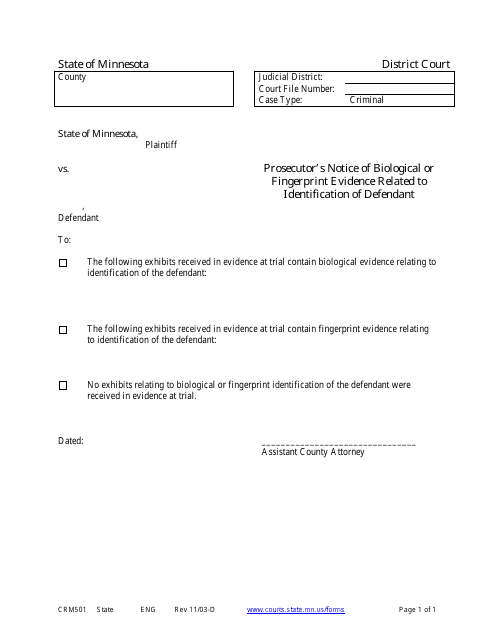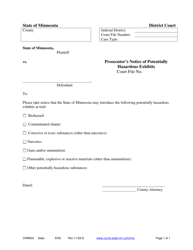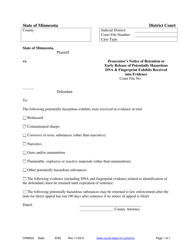Form CRM501 Prosecutor's Notice of Biological or Fingerprint Evidence Related to Identification of Defendant - Minnesota
What Is Form CRM501?
This is a legal form that was released by the Minnesota District Courts - a government authority operating within Minnesota. As of today, no separate filing guidelines for the form are provided by the issuing department.
FAQ
Q: What is CRM501?
A: CRM501 is the form for Prosecutor's Notice of Biological or Fingerprint Evidence Related to Identification of Defendant in Minnesota.
Q: What is the purpose of CRM501?
A: The purpose of CRM501 is to notify the defendant and the court of the existence of biological or fingerprint evidence related to the identification of the defendant in a criminal case.
Q: What does the CRM501 form include?
A: The CRM501 form includes information about the biological or fingerprint evidence, such as its nature, location, and the method of identification used.
Q: Who needs to fill out the CRM501 form?
A: The prosecutor is responsible for filling out the CRM501 form and providing it to the defendant and the court.
Q: When should the CRM501 form be filed?
A: The CRM501 form should be filed as soon as the prosecutor becomes aware of the existence of the biological or fingerprint evidence.
Q: What happens after the CRM501 form is filed?
A: After the CRM501 form is filed, the court will schedule a hearing to determine the admissibility of the evidence.
Q: Can the defendant challenge the admissibility of the evidence mentioned in the CRM501 form?
A: Yes, the defendant can challenge the admissibility of the evidence mentioned in the CRM501 form during the hearing.
Q: Is the CRM501 form specific to Minnesota?
A: Yes, the CRM501 form is specific to Minnesota and is used in the state's criminal justice system.
Form Details:
- Released on November 1, 2003;
- The latest edition provided by the Minnesota District Courts;
- Easy to use and ready to print;
- Quick to customize;
- Compatible with most PDF-viewing applications;
- Fill out the form in our online filing application.
Download a printable version of Form CRM501 by clicking the link below or browse more documents and templates provided by the Minnesota District Courts.




